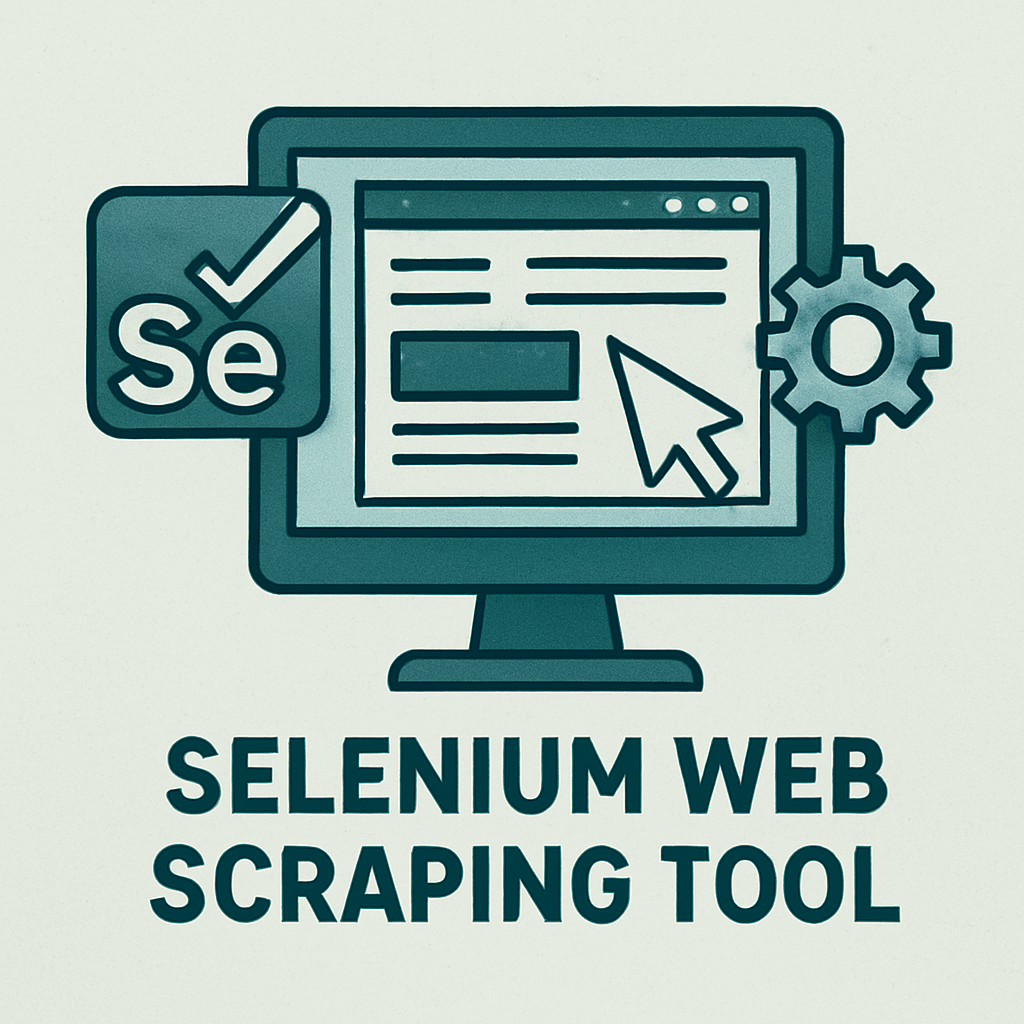
Selenium is a popular open-source tool used for automating web browsers. It provides a suite of tools and libraries that enable you to interact with web pages like a human user. This interaction mimics real user behavior, allowing you to perform tasks such as clicking buttons, filling out forms, and navigating between pages. Such capabilities make Selenium an ideal choice for web scraping, where such interactions are often necessary to extract data that is not readily available on the static front-end of a webpage. By automating these interactions, Selenium can effectively gather data from dynamic and complex websites.
Why Choose Selenium for Web Scraping?
Selenium is not the only web scraping tool available, so why choose it? Here are a few compelling reasons:
- Browser Automation: Unlike other tools, Selenium allows you to automate browser actions, which means you can scrape data from websites that require user interaction or JavaScript rendering. This ability to handle dynamic content sets Selenium apart, as many modern websites rely heavily on JavaScript to deliver content to users.
- Flexibility: Selenium supports multiple programming languages, including Python, Java, C#, and Ruby, making it accessible to a wide range of developers. This flexibility ensures that developers can leverage Selenium's capabilities regardless of their preferred coding language, streamlining the integration into existing workflows.
- Community Support: With a large community and extensive documentation, finding solutions to any issues you encounter is straightforward. The active community provides a wealth of resources, including tutorials, forums, and example scripts, making it easier for both beginners and experienced developers to troubleshoot and optimize their web scraping efforts.
Setting Up Selenium for Python Web Scraping
Before diving into web scraping with Selenium, you need to set up your environment. Here's a simple guide to get you started with Selenium and Python:
Step 1: Install Python
Ensure Python is installed on your system. You can download it from https://www.python.org/downloads/. Follow the installation instructions specific to your operating system. During installation, make sure to check the option to add Python to your system's PATH, as this will simplify running Python scripts from the command line.
Step 2: Install Selenium
Once Python is set up, install Selenium using pip, Python's package installer. Open your terminal or command prompt and run:
pip install selenium
This command will download and install the latest version of Selenium, along with any dependencies required for its operation. Keeping Selenium updated ensures that you have the latest features and bug fixes.
Step 3: Download WebDriver
Selenium requires a WebDriver to interact with browsers. Download the appropriate WebDriver for your browser of choice:
- Chrome: Download from https://sites.google.com/chromium.org/driver/.
- Firefox: Download from https://github.com/mozilla/geckodriver/releases.
- Safari and others: Follow the respective setup guides provided by the browser developers.
Place the WebDriver executable in your system's PATH for easy access. This setup allows Selenium to launch and control your chosen browser, enabling the automation of web interactions necessary for scraping.
Writing Your First Web Scraping Script
Now that your environment is set up, let's write a simple script to scrape data using Selenium. This script will serve as a foundation that you can expand upon as you become more familiar with Selenium's capabilities.
Step 1: Import Necessary Libraries
Start by importing the required libraries in your Python script:
from selenium import webdriver from selenium.webdriver.common.by import By
These imports bring in the necessary classes and methods to control the browser and locate elements on the web page. The By class provides a convenient way to specify how to locate elements, such as by ID, name, or XPath.
Step 2: Initialize the WebDriver
Create an instance of the WebDriver to control the browser:
driver = webdriver.Chrome() # or webdriver.Firefox() driver.get('https://example.com')
This code snippet launches the Chrome browser and navigates to the specified URL. You can substitute webdriver.Chrome() with webdriver.Firefox() or another browser if preferred. The get() method loads the webpage, readying it for interaction.
Step 3: Locate and Extract Data
Use Selenium's functions to locate and extract data. For example, to extract text from a specific element:
element = driver.find_element(By.ID, 'element-id') data = element.text print(data)
This example locates an element by its ID and retrieves its text content. You can adapt this approach to locate elements using different attributes or extract other types of data, such as attributes or inner HTML.
Step 4: Close the Browser
After extracting the data, close the browser to free resources:
driver.quit()
This step is crucial to ensure that the browser instance is properly terminated, freeing up system resources and preventing memory leaks. Proper resource management is essential, especially when running multiple scraping scripts or automating large-scale data extraction tasks.
Advanced Techniques for Selenium Web Scraping
Once you're comfortable with basic web scraping, it's time to explore advanced techniques to enhance your scraping capabilities. These techniques will allow you to tackle more complex scenarios and improve the efficiency of your scripts.
Handling Dynamic Content
Many modern websites use JavaScript to load content dynamically. Selenium's ability to interact with JavaScript makes it ideal for scraping such content. Waits can be implemented to ensure all elements are loaded before extraction:
from selenium.webdriver.support.ui import WebDriverWait from selenium.webdriver.support import expected_conditions as EC
element = WebDriverWait(driver, 10).until(EC.presence_of_element_located((By.ID, 'dynamic-element')))
This approach uses explicit waits to pause script execution until a specified condition is met, such as the presence of a specific element. Handling dynamic content effectively ensures that your scripts do not fail or extract incomplete data due to loading delays.
Using Proxies for Web Scraping
When scraping data, especially in large volumes, using proxies is crucial to avoid IP blocking. Websites often monitor traffic and may block requests if they detect scraping activity from a single IP address. Mobile proxies can be particularly effective, as they rotate IP addresses and mimic real user traffic, reducing the likelihood of detection. By distributing requests across multiple IP addresses, proxies help maintain access to target sites and prevent disruptions in data collection.
Headless Browsing
For increased efficiency and speed, consider using headless mode. This allows Selenium to run without opening a browser window, saving system resources:
options = webdriver.ChromeOptions() options.add_argument('headless') driver = webdriver.Chrome(options=options)
Headless browsing is particularly useful when running scripts on servers or environments without graphical interfaces. It reduces overhead and speeds up script execution, allowing for faster data extraction without compromising the functionality of your scraping tasks.
Conclusion
Mastering Selenium for web scraping empowers you to extract valuable data from the web efficiently. From setting up your environment to implementing advanced techniques like handling dynamic content and using proxies, Selenium offers a robust framework for all your web scraping needs. By following this guide, you can harness the full potential of Selenium, transforming complex web scraping tasks into manageable solutions. Whether you're a seasoned developer or a newcomer to web scraping, Selenium is a tool worth mastering. It bridges the gap between human interaction and automation, making it indispensable for any data-driven project. Start experimenting today and unlock a world of data at your fingertips.
By continuously refining your skills and exploring new features, you can stay ahead in the ever-evolving landscape of web scraping. With Selenium, the possibilities are vast, opening up opportunities for innovative applications and insights that can drive your personal or business projects forward.
Frequently Asked Questions (FAQ)
1. What is Selenium, and why is it used for web scraping?
Selenium is an open-source tool used for automating web browsers. It is widely used for web scraping because it can simulate human interaction with web pages, allowing you to extract data from websites that require user actions or JavaScript rendering.
2. Do I need programming skills to use Selenium for web scraping?
While having programming skills, particularly in Python or another supported language, is beneficial, there are numerous tutorials and examples available that can help beginners get started. Basic knowledge of coding concepts will make it easier to understand Selenium's functionalities.
3. Can I use Selenium with any web browser?
Yes, Selenium supports multiple web browsers, including Chrome, Firefox, Safari, and Edge. You can choose the browser that best fits your needs by downloading the appropriate WebDriver.
4. Is web scraping legal?
Web scraping legality varies by jurisdiction and the specific website's terms of service. Always check the website's robots.txt file and terms of service before scraping. It's important to respect the rules set by website owners and legal guidelines.
5. How can I avoid getting blocked while scraping?
To avoid IP blocking, you can use proxies, such as mobile proxies, that rotate IP addresses. Additionally, implementing delays between requests and using headless browsing can help mimic human behavior and reduce the chances of detection.
6. What are some common issues faced when using Selenium for web scraping?
Common issues include handling dynamic content, managing page load times, and dealing with CAPTCHAs. Implementing explicit waits and using headless mode can help mitigate some of these challenges.
7. Which mobile proxy provider should I choose for large-scale scraping?
We recommend Aluvia—they offer a vast, rotating mobile IP pool, lightning-fast connections, and 24/7 support to keep your Selenium scripts running smoothly without interruption.
Ready to scale your web scraping hassle-free?
Choose Aluvia today and power up your Selenium projects with robust, reliable mobile proxies!








